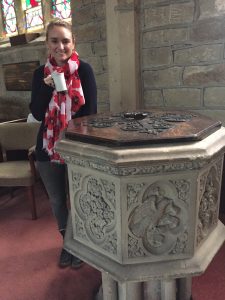
Anna at the font at Christ Church, Sowerby Bridge, Nov 2017
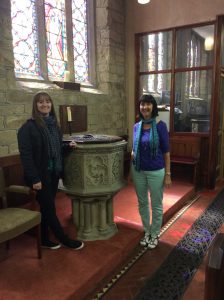
Rachel and I on our first visit, 2015
George Gledhill, my great great granddad was born May 26th, 1837 and baptized at Christ Church, Sowerby Bridge on June 25th along with 22 other children! In 2015 on my trip to England with Rachel we visited the church in order to see where George had been baptized. We attended a coffee morning and were greeted with open arms by the parishoners and the minister, Angela Dick. I was even able to play the organ in the church. Since then the Tuesday morning coffee mornings have become frequent entries into my diary and I keep in touch with what’s going on at the church. It transpired that one of the ladies I met, who is another person interested in geneaology, is actually a distant relative of mine, through our common Barraclough ancestors.
Christ Church was opened on the 24th May 1821, (my birthday) but its roots go back much further in time, nearly 300 years before, to 1526. In that year a chapel of ease was built to serve the people of the townships of Warley, Norland and part of the township of Skircoat, in the ancient Parish of Halifax. It was situated on low-lying ground just opposite the junction of the Ryburn stream with the River Calder, between a fulling mill to the east and Sowerby Bridge to the west. I’ve recently been to find the site but nothing remains.
At the end of 1828, a mere seven years after the church opened, it was found that the roof of the nave was unsafe. The ridge had sunk eight inches in the middle pushing the crenellations and upper parts of the walls outwards, on the north side to the extent of four inches. The church was closed for two months whilst the roof was propped as a temporary measure. Repair work eventually began in August 1830, the church being reopened on Sunday, 20th March 1831. So when George was baptised there the church had been in its present state for only 6 years.

Cote Hill. I go along this road every time I go into Halifax and didn’t know that this area was called Cote Hill until I did the research about George

Warley, photo taken 2015, with Rachel
At his baptism his address is given as Warley. Warley is a large tract of beautiful rolling hills, with a small village on the hill inappropriately named ‘Warley Town.’ Ir’s a lovely little village where the author Phyllis Bentley lived in a house once lived in my Rev Patrick Bronte, father of the famous Bronte writers. On the 1841 (aged 4) census he is living at Coat, now Cote Hill.Cote Hill is the area around the Burnley Road, near Warley, between King Cross and Sowerby Bridge. With George is father John, 30, a cart driver, and mother, 25 and 2 younger siblings, Thomas, 2, and James 4 months. Before the next census, in 1851, 4 other siblings were born, Robert, Rachel, David and Nancy. By 1851 the family is living at 1 Regent Court, Orange Street, Halifax. Father John is a drayman. A drayman was historically the driver of a dray, a low, flat-bed wagon without sides, pulled generally by horses or mules that were used for transport of all kinds of goods. In 1846 his brother James died, aged 5 and in 1853 his 4 year old sister Nancy died. Two other siblings were born before the 1861 census, John and Maria.
On June 17, 1857 I have him marrying Mary Peel at St Peter’s in Birstall, both George and Mary living at Flush in Liversedge. This just doesn’t seem correct since it’s so far away – well, for those days! Actually I just looked it up and it’s only 8.8 miles from Halifax. Birstall is 3 miles from Flush. Flush is described in Wikipedia as ‘the place where the mills of the woolen industry stood.’ The 1881 census lists the following – all born at Liversedge. I think this proves that it’s a different family in Liveredge – not ‘mine.’ George Gledhill 43, Mary Gledhill 41, Arthur Gledhill 21, Albert Gledhill 17, Thomas Gledhill 7, Elizabeth A. Gledhill 5.
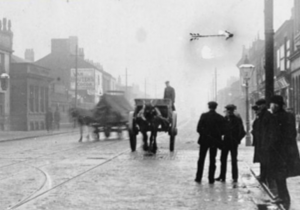
Ancoats, 1904

Henry Street, Ancoats, 1900
George is now an ‘overlooker’ presumably in one of those mills. Samuel Gledhill was a witness, and again that makes me unsure since I don’t have a Samuel in George’s immediate family. 1861 finds the newly weds living as boarders at 15 Henry Street, Ancoats, Manchester. Historically in Lancashire, Ancoats became a cradle of the Industrial Revolution and has been called “the world’s first industrial suburb”. For many years, from the late 18th century onwards, Ancoats was a thriving industrial district. The area suffered accelerating economic decline from the 1930s and depopulation in the years after the Second World War, particularly during the slum clearances of the 1960s. Since the 1990s Ancoats’ industrial heritage has been recognised and its proximity to the city centre has led to investment and substantial regeneration.
In 1861 George is a porter with both wife Mary and himself born in Halifax. 2 years later their son Thomas Wardle Gledhill was born on July 28th. Wardle sounds like an ancestor’s surname but I haven’t found anyone. Soon after the birth, between July and September of that year Mary died. Two and a half years later George remarried 1865 Dec 18 Register office, Halifax which means that he had moved back to Yorkshire after Mary’s death. His second wife was Charlotte Haigh. I know this is correct because George was a widower, aged 28. He was a drayman. Father John Gledhill was also a drayman Orange Street, Halifax. Orange Street still exists but it’s just roads and car parks. The following year their son, Abraham was born in Rastrick. Two years later a daughter was born in Salterhebble, Sarah who was my great grandma. The census of 1871 see the growing family living at 4 Bath Street,Halifax. I’d found Bath Street in June 2016. It’s adjacent to the station but the houses on it were demolished when the land was bought by the railway. The baths after which it was named were an elegant affair with formal gardens, modeled on Roman baths, a place to be seen, not the slipper baths which were a necessary function of everyday life without bathrooms in homes. Also known as Halifax Baths and Pleasure Grounds, and by the rather boastful title of Greece Fields these
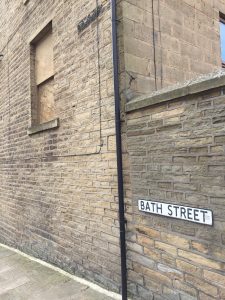
Bath Street today

This imposing building was once Halifax railway station where George worked. When I took this photo the glowing stone and the style of ornamentation reminded me of India
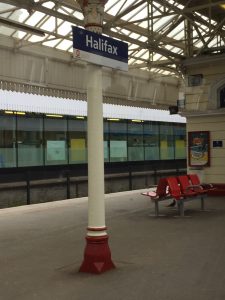
Platform at Halifax station today
extensive facilities were developed by Thomas Rawlinson at Coldwell Ing near the Hebble Brook at Lilly Lane. They opened in 1793 on the east side of Hebble Brook. They were the only local public baths at the time. The facilities were said to be the finest and most extensive suite of baths in Yorkshire, including bowling greens, quoits area, shrubberies and landscaped gardens with sculpture, a dining room, shower baths, swimming baths, medicated and sulphur baths, and hot, cold and tepid baths. A membership fee was charged for the use of the facilities. The baths were supplied by fresh-water springs which rose in Greece Fields. The privately-owned baths, which were built of red brick, closed in 1853 and were sold to make way for the railway. This makes perfect sense because on the census of 1871 George, now 32, is a railway porter. His wife Charlotte, born in Rastrick is a dressmaker. Their children are Abraham Gledhill 5, and Sarah Gledhill 3. Samuel Appleyard 26 is a lodger. Their daughter Ann was born in 1875.
However, in the meantime, George was getting up to no good. On 30th April 1879, at the age of 41he was sentenced to 6 months imprisonment at Wakefield prison for threatening Charlotte Gledhill. It’s difficult to read the sentence since it’s buried in the fold of the prison record book but it definitely records that George was issued with a fine of £20 plus something else. At the time George was 5 ft 4 ½” with brown hair. Date of discharge is October 29, 1879. Less than 2 years later George’s name crops up in the Bradford Daily Telegraph on Saturday March 26, 1881:
George Stott, wire drawer, of the same place, was charged with making use of provoking language Charlotte Gledbill, wife of George Gledhill, Battison Road, tending to create breech of peace, on the 19th inst. The defendant was ordered to pay fine of 5s and 9s 6p costs , or in default serve ten days.
On the 1881 census Charolotte is living at 51 Battison road Halifax
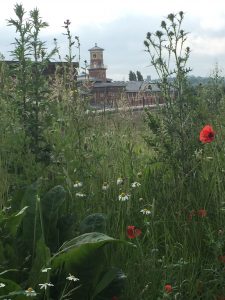
Wakefield prison as seen from the railway platform
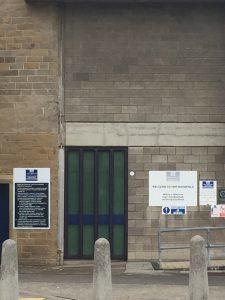
The prison entrance I got a little too close to.
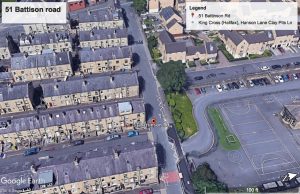
Battison Street runs vertically on this photo. Presumable #51 would have been situated where the school now is
and is the housekeeper for William Wolfenden, a 30 year old widower with 3 small children. Note: at #61 Battison lives James Gledhill Wardle! He is aged 37 of and was born in Soyland. He’s married to Mary, 39 of Barkisland. Since George’s son , born 1863, is called Thomas Wardle Gledhill I’m sure there must be some connection but I’ve been unable to trace James Gledhill Wardle on any other documents so far! On the 4th of July George was again in trouble, this time for being a ‘rogue and a vagabond’ and he’s sentenced to 14 days in Wakefield prison, though he was committed at Dewsbury. This time he’s recorded as 5 ft 6 ¾” with brown hair ‘with a boil mark on the back of his neck.’ He’s listed at being 46 (in 1881). In June 2016, I had successfully, but inadvertently, managed to get myself into Wakefield’s top security prison. Having learned of George’s incarceration there I wanted to document my visit by taking a photo to commemorate the occasion. I looked around carefully for ‘No photography’ signs but couldn’t see any so I began taking photos of the entrance. Within 30 seconds a prison guard came running out demanding my cell phone! As I explained that there was nothing to say I couldn’t she shepherded me into the prison itself. Yeah! Just what I’d hoped for , but not quite in this way. Explaining myself to another guard he told me it was fine to take photos from across the street, which I duly did. The prison is mainly Victorian, though parts date back to the 1500’s. There’s a mulberry tree in the center of the exercise yard and legend has it that this accounts for the nursery song Her We Go Round the Mulberry Bush.
Meanwhile back at the ranch there is this account of what is befalling Charlotte:
Sheffield Independent – Wednesday 09 April 1873 entitled A Brutal Fellow
George Harris, 23, carpet printer, was sent to gaol for six months, for unlawfully and maliciously wounding Charlotte Gledhill, at Halifax, on the 26th of February. Mr. Wilber- force prosecuted. The man, who lived with the prosecutrix as her husband, had a quarrel with his paramour, and knocking her down, kicked the woman on the legs and face, until her jaw was broken, and her body seriously bruised. It’s obvious that George and Charlotte were living pretty rough, tough lives. I find it very poignant to look into the eyes of Sarah, their daughter, in photographs and know just fragment of her parents’ story.
For a long time I’ve been unable to find further references to George. I’d had no luck finding him on an 1881 or1891 census, neither could I trace his death. In November, 2018, I contacted roger Beasley from the Calderdale family history society and he also drew a blank. I decided to obtain a death certificate from the General Registry Office. It was a shot in the dark because there are many George Gledhills but luck was with me because recorded as being present at ‘this’ George Gledhill’s death was his son T. W Gledhill. Since I know that one of George’s sons was Thomas Wardle Gledhill then the death certificate must be from my George. Success! His place of residence at his death is given as 5 Fleet Street, Halifax, a place previously unknown to me – therein lies some more research needed.
Update: May, 2019
Fleet Street was in a part of Halifax known as The City, just north of the town centre. This was a densely populated area at Cross Fields with an estimated 780 people living in a maze of back-to-back houses, courtyards, dimly-lit shops, and narrow streets.

Residents of The City 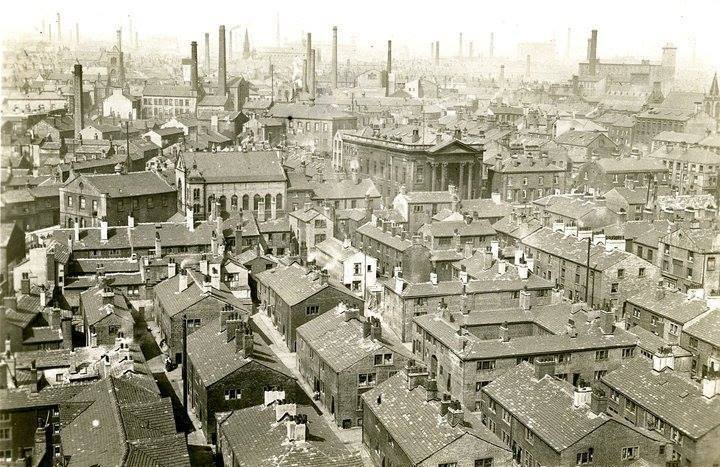
The City 
The City demolished
Leave a Reply